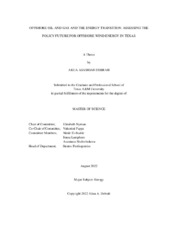| dc.contributor.advisor | Nyman, Elizabeth | |
| dc.contributor.advisor | Pappa, Valentini | |
| dc.creator | Debrah, Akua Asamoah | |
| dc.date.accessioned | 2023-05-26T18:20:24Z | |
| dc.date.available | 2023-05-26T18:20:24Z | |
| dc.date.created | 2022-08 | |
| dc.date.issued | 2022-07-27 | |
| dc.date.submitted | August 2022 | |
| dc.identifier.uri | https://hdl.handle.net/1969.1/198160 | |
| dc.description.abstract | The energy sector, including transportation, accounts for about 75% of greenhouse gas emissions nationally. As a result, national efforts in line with globally-centered climate mandates have set standards to ensure that emissions are controlled, and renewable forms of energy enhanced. Of these renewable energy enhancements, offshore wind energy shows one of the greatest potentials to assist in reaching the goals in the Paris Accords. However, till date there remains only two active offshore wind farms in Rhode Island and Coastal Virginia, despite the State of Texas being the national leader in onshore wind energy. This thesis examined the potential for offshore wind energy in Texas by drawing parallels between the offshore oil and gas and wind sectors using technological innovation systems (TIS) framework and a timeseries modeling approach. The discussions of the seven functions in the TIS showed that as a very mature industry, offshore oil and gas has had immense support from the State. Also, the current growth trajectory of onshore wind is heavily attributed in part to non-market renewable energy strategies and drivers by the State in the late 1990s. In answering the question of whether a policy future for offshore wind exists, a hypothetical case was made by modeling reduction scenarios in conventional fuels should global and national mandates intensify for renewable energy generation. Since wind production requirements may increase as reductions hypothetically happen, justification for offshore wind in the Gulf of Mexico was shown to likely meet Texas’ future renewable electricity needs. Furthermore, it was identified that a future policy for offshore wind may exist in the not-too-distant-future for the State. Lessons from Block Island Wind Farm and the TIS assessment were contextualized as (pre)conditions and recommendations to kick-start an offshore wind industry in Texas. | |
| dc.format.mimetype | application/pdf | |
| dc.language.iso | en | |
| dc.subject | Energy Transition | |
| dc.subject | Offshore Wind Energy | |
| dc.subject | Technological Innovation System | |
| dc.subject | Policy Analysis & Modeling | |
| dc.subject | | |
| dc.title | Offshore Oil and Gas and the Energy Transition: Assessing the Policy Future for Offshore Wind Energy in Texas | |
| dc.type | Thesis | |
| thesis.degree.department | College of Engineering | |
| thesis.degree.discipline | Energy | |
| thesis.degree.grantor | Texas A&M University | |
| thesis.degree.name | Master of Science | |
| thesis.degree.level | Masters | |
| dc.contributor.committeeMember | Elbashir, Nimir | |
| dc.contributor.committeeMember | Lamphere, Jenna | |
| dc.contributor.committeeMember | Shcherbakova, Anastasia V. | |
| dc.type.material | text | |
| dc.date.updated | 2023-05-26T18:20:25Z | |
| local.etdauthor.orcid | 0000-0002-6653-3403 | |


